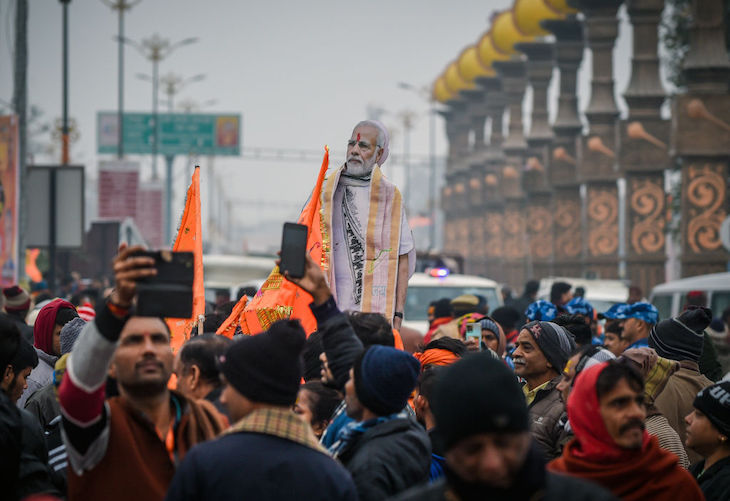The religious and political symbolism was unmistakable, as the Indian prime minister Narendra Modi led the consecration of a controversial new Hindu temple in Ayodhya, in Uttar Pradesh state, built on the ruins of a 16th century mosque.
The Babri Masjid was torn down by Hindu nationalist mobs in 1992, sparking riots across the country that killed about 2,000 people, most of them Muslim. In 2019, India’s Supreme Court ruled that a temple could be built on the site, a decision that was roundly criticised by India’s Muslim minority.
Modi spoke of India being at ‘the beginning of a new era’
The festering wounds from this long-running dispute reverberate to this day. The opening ceremony – even before construction of the temple is complete – amounts to a calculated statement by Modi. It marks the latest and most significant step in his mission to transform India from a secular democracy into a Hindu state. It also honours a vow made by the ruling Bharatiya Janata Party to build a new temple on the disputed Ayodhya site, a pledge that helped pave its way to power. Modi will be hoping that Hindu voters reward him and his party in the general election this year.
The celebrations, dedicated to Lord Ram – one of Hinduism’s most revered deities – were predictably lavish. Modi welcomed some 8,000 dignitaries, including business leaders, Bollywood film stars and prominent cricketers. India’s elites are in thrall to Modi’s political genius, or perhaps too wary to voice much in the way of meaningful dissent. Many Indian schools and colleges declared a public holiday and civil servants were given time off. Even the stock markets closed for the day and television news channels cleared their scheduled to broadcast the proceedings non-stop.
Modi, dressed in a traditional kurta tunic, led the ceremony, as priests chanted hymns inside the temple’s inner sanctum, where a sculpture of Lord Ram had been installed. Modi spoke of India being at ‘the beginning of a new era’. Words matter, but it is the television imagery that conveys the story India’s rulers want to sell to the electorate. Hundreds of millions of Hindus will have seen the pictures of Modi personally restoring the deity Lord Ram to his birthplace: an image that no amount of election advertising can hope to buy. It is all part and parcel of a bigger and long-term political project to reclaim Hindu pride, something that Modi and his party claim was belittled during the centuries of Mughal rule and British colonialism. It is a message that resonates powerfully in a country where Hindus make up 80 per cent of the population of 1.4 billion.
What then of India’s hapless and hopeless opposition parties? They appear to have no real strategy or even the most basic idea of how to go about countering the dominant narrative of the government.
The leaders of India’s main opposition Congress party boycotted the event at the temple, accusing Modi of politicising a religious event. They have a point but is anyone listening? Modi appears to have succeeded in reducing his opponents to a mere sideshow.
The lack of a strong opposition is a worry for the future of Indian democracy. Critics regularly accuse the government of a crackdown on basic freedoms. There are also worries about growing violence against Muslims, Christians and other religious minorities.
If Modi wins a third successive term in office later this year – and he is the clear favourite – he would become one of India’s longest-serving leaders ever. That is more than enough time in almost untrammelled power to complete the task of remoulding the country and its institutions to his liking.
The inauguration ceremony of the Hindu temple in Ayodhya is replete with symbolism in ways that go beyond Modi. India’s modern day founding fathers, who fought and won the battle for independence from British rule, strongly believed that the best hope for the country lay in secular democracy, as a way of preventing widespread communal conflict. Modi has a different vision altogether and his time in power has seen a steady erosion of secular values, blurring the boundary between the state and religion. It falls to Indian voters to decide what kind of India they want.







Comments